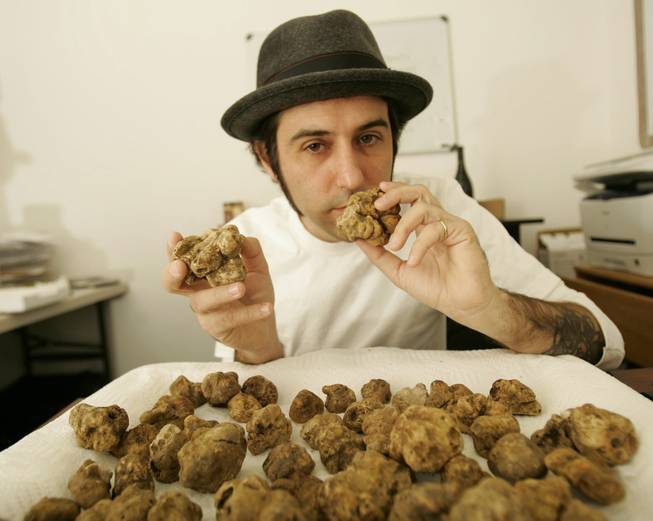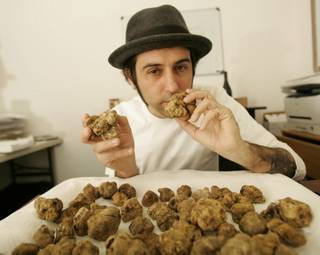
RICHARD BRIAN / SPECIAL TO THE SUN
Joseph Magnano, West Coast district manager for Sabatino Truffles, inspects a fresh batch of truffles shipped from Italy. Magnano said his truffles cost around $150 an ounce.
Friday, Oct. 16, 2009 | 2 a.m.
Sun Coverage
Beyond the Sun
- North American Truffling Society: Frequently Asked Truffle Questions
Every week, even in the midst of the recession, patrons of high-end Las Vegas restaurants indulge in one of the world’s most expensive and evanescent ingredients: truffles.
Like so much about Las Vegas, truffles are an audacious triumph of decadence over geography.
Truffles are the most regional of regional foods. Found primarily in Northern Italy, Croatia and France (and cultivated in Australia), truffles grow underground amid trees and must be hunted with hogs or dogs, animals whose powerful noses can locate the pungent fungi. Once it is dug up, a truffle is at its peak of freshness for perhaps 10 days. A day or two of that will be spent getting the truffle from hunter to a buyer, and another day may be spent sorting and preparing the truffles for shipping.
Before truffles can be shaved onto dinners in Las Vegas, they must travel about 6,200 miles.
First they are flown to New York, where they usually arrive in the evening and must pass a customs inspection for worms and other parasites. This is the most fraught part of the journey for Las Vegas’ truffles.
The largest importer of fresh truffles into Las Vegas is Sabatino Tartufi, a New York truffle and olive oil purveyor supplying, by its own estimate, 70 percent of the Strip. For its truffles to arrive here the next morning and be delivered to restaurants before dinner, Sabatino employees must sort, weigh, divide and deliver the truffles to FedEx by 10 p.m.
There are currently two kinds of truffles in season: Burgundy truffles, selling to restaurants for $300 per pound, and the intense white truffles, which are going for $2,500 per pound. Truffles are priced by the pound and sold by the ounce, and every day they are out of the ground, they lose 3 percent of their weight.
Sabatino’s Las Vegas salesman, Joe Magnano, has buyers for two-thirds of his product when he picks up his truffles at 8 a.m. at the FedEx office near McCarran International Airport. At his small warehouse nearby, he inspects them for worms and rot, the most common hazards for a fungus that grows underground. Magnano uses a small folding knife with a surgeon’s care and gently scrubs the truffles with a toothbrush, removing some, but not too much, dirt. He sorts them by size, a sorting he’ll undo when he packs them for sale and artfully scatters the larger truffles among the crowd.
The most important way to sort truffles is by smell. Bad ones are easy to smell, with the most common flaw being a whiff of ammonia, Parmesan cheese and wet dog. Others smell like the fresh rubber of a shoe’s sole or greasy potato chips.
Correct truffle odors are harder to describe. Burgundy truffles smell something like freshly turned loam, pepper and maybe roasted garlic. White truffles are harder to define: fresh garlic, chives, pepper, fennel, loam, dirt, and is that broccoli? It’s like every vegetable blended together, then combined with something else that slithers down your nose and tickles the back of your tongue. All truffles have this meaty smell. It’s what has earned them the kitchen nickname of “French MSG.”
Magnano, a 32-year-old culinary school graduate and self-described “pot stirrer,” was ill-suited for the close quarters and overly familiar faces of a Las Vegas kitchen.
So he roams among the kitchens, perhaps five or six of them a day on the two or three days a week when he has fresh truffles to sell, haggling over price with every chef. He lets chefs pick their truffles from his shipments, though he sets some of the choice truffles aside to repay a favor to a particular chef or to make sure that there are still some nice truffles left for the chefs he meets near the end of his day.
The chefs will use his truffles mostly on pastas and risottos. One restaurant, Andre’s at the Monte Carlo, sells a cocktail made with foie gras and truffle. The usual serving of truffles is six or eight grams shaved fresh onto the dish, often tableside by a white-gloved server, as at Le Cirque in the Bellagio, where diners pay an extra $70 for truffled appetizers and an extra $130 for entrees.
Next door at Circo, executive chef Vincenzo Scarmiglia once sold a party of six a whole 12-ounce white truffle for $8,000 and shaved it onto their food for them. That was in more prosperous times, of course, when truffles cost more and Circo was buying 2 1/2 pounds a week. Now the restaurant is using an austere 1 1/2 pounds.
It remains Magnano’s best customer.
To spend the day with a small sampling of these two kinds of truffles is to be awed by Magnano’s enduring tolerance of truffles by the pounds. Smelling the 3.2 pounds of white truffles that Magnano had to sell Wednesday is like having a wild boar insert itself into your nostrils. Interesting at first, but after seven hours you wish the boar would stop.
He doesn’t mind the smell, he says.
But it does linger in his nose for a couple of days.


Join the Discussion:
Check this out for a full explanation of our conversion to the LiveFyre commenting system and instructions on how to sign up for an account.
Full comments policy